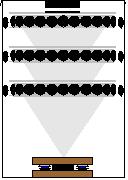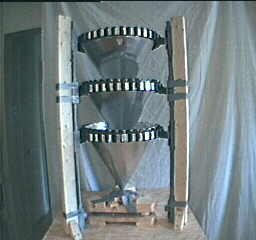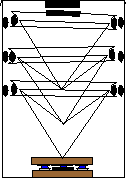The objective of this experiment is to duplicate the results of David Hamel with regards to his 45 gallon drum experiment.
Warning - I have not yet adjusted my version of the drum to match everything that David Hamel has told me. A new version would mean starting from scratch so I haven't begun yet. On the bright side, if I hadn't built mine and taken them to show David, I wouldn't have gotten his feedback like I did.
Warning - Due to the fact that those who claim to have had successful results with this technology did so with designs that differs from David Hamel's original, there may in fact be a number of configurations that work.
My Work
- Results of my visits with David Hamel.
- The Hamel 45GD - Mark 2 (my latest attempt - April to ... 2000).
- The Hamel 45GD - Mark 1 (my first attempt - July to September 1999).
- Details of my own attempt using Steve Thompson's motor approach along with my Hamel 45GD Mark 1. Note that this attempt was abandoned due to unsolvable problems due to too large spacing between cone rim and drum rim.
The Basic Device
|
|
|
The basic device consists of three cones. According to David, there should be three but one of the claims of success were done with a two cone system. Each cone sits within the one below it. Each cone sits on a point halfway down the cone below it. These cones are in a 45 gallon drum. The rim of the cones have ceramic magnets attached to them. These magnets repel rings of ceramic magnets in the 45 gallon drum. The top cone has an extra ceramic magnet centered within its rim. When the cones are balanced, sitting in the drum, the cover of the drum is put on. In the cover is another ceramic magnet which repels the top cone's centered magnet. This causes the top cone to move off-center (or wobble). That in turn causes the cone in which the top cone is sitting to also wobble but in the opposite direction - and so on. Most designs also have what is typically called an oscillator sitting on the base of the drum instead of just a fixed notch. This oscillator allows further wobbling.
The following is an excerpt from the book "The Granite Man & the Butterfly" as told to Jeanne Manning by David Hamel. It is of David's experience in testing his 45 gallon drum device while he was living in Maple Ridge, BC, Canada. The reference in the first paragraph about having seen something before is a reference to his alien experience. This book is no longer in print but if you are serious about building this device then it is well worth tracking down a copy.
Finally he felt ready to build a small model similar to the cone-above-cone-above-cone power generator that he had seen. Many of the materials he used came from scrounging in junk yards. Bicycle rims served as the base of his handmade aluminium cones and held the magnets that were taped on with electric tape. Magnets, spaced just right, achieved a rejection force. Working in the garage attached to their house, he placed the apparatus inside a 45-gallon black steel barrel ringed on the inside with magnets. The barrel would be the shell of the device.
Everything lined up. Then he screwed down the cover. This compressed the apparatus forcing the isotope line to break into three parts and starting the tumbling motion passed on from one to the other The rings of magnets repelling each other caused the cones to float one over the other. They swung in a constant wobbling circling motion, faster and faster. After they reached a certain speed the vibration somewhat stabilized.
David was pleased that his model operated. He went into the house to share his success and attend to Nora's needs, leaving the experimental device running. As he shut the French doors between the garage and the living room, he was unconcerned that the device was wobbling away in the barrel with its cap on. He was certain that the relatively small apparatus would not produce an energy effect, and he expected that it might soon stop its wobbling. He wanted to see how long it would run. If the motion continued until morning, he would be very surprised, he thought.
"It'll never fly. But maybe I can learn from it," he told Nora.
The couple went to bed and slept until they were awakened by an extremely loud bang. "Fire!" Nora said.
David jumped out of bed and looked toward the attached garage. A red glow came from that direction through the French doors and lit the living room. From the bedroom, it did look as if the garage was on fire!
Inside the garage, he encountered a dismaying sight. His carefully-built device had exploded out of the drum and was scattered in pieces all over the room. Apparently the red glow had been from a buildup of energy of some type as the device operated. There was no fire, fortunately, but his investment of thousands of dollars in magnets was destroyed.
The mess of metal and the broken roofing shakes on the top of the building were not as discouraging to David as the loss of all those ceramic magnets. However, he had the satisfaction of seeing that he could build something which demonstrated the power of the magnetic repulsion coupled with the arrangement of the "breaking lines".
Click here for my theory on how it works.
The Hamel spinner misconception
Just a warning about something called the "Hamel spinner". During one of my visits David showed me what people call the Hamel spinner. He said its purpose was to show the butterfly motion, the wobbling motion that the cones make. Its purpose was NOT to show a way of making magnets spin perpetually. Likewise, the objective of this 45 gallon device is to make the cones wobble, and in fact the wobble will be so small that it's often called a vibration. The purpose is not to make the cones spin, as is a common misconception.
Discussion/Information Group to Join
Yahoo! hameltech discussion group with many files, photos, ...




